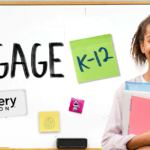Mitch Slater was a classroom teacher and site administrator for 20 years before starting Levered. Mitch spent his teaching career focused on developing curricula and instructional strategies to more effectively support and challenge the diverse learners in his own classroom.
What does Levered do?
Levered provides schools with a complete standards-aligned instructional system for 3rd-5th grade math, built around an online competency-based Common Core curriculum that students work through at their own pace. We took a systems-level approach to reimagine technology supported math instruction. Real-time assessment data from students’ independent online work drives lesson planning, intervention, and enrichment, so teachers can stop grading papers and photocopying, and focus on data-informed direct instruction when and where it’s needed.
We piloted Levered for three years in California classrooms, starting in 2017. Last year we launched our complete 4th grade curriculum, expanding to the full 3rd-5th grade program this school year. In 2018 and 2019, Title I schools that hit our minimum implementation benchmarks saw state test (SBAC) score growth in math increase 70% in their first year, compared to the same grade level cohort the year before.
Does Levered approach product development from an equity and access point of view?
While I was still an undergrad, I started learning Spanish so that I would be able to work with English Learners when I became a teacher, and my first full time teaching job was with 34 fifth graders in a Sheltered English Immersion Class in Watsonville, CA. My mother was a special education teacher for most of my life, and I grew up knowing what an IEP was, and why they were important. For us, Equity and Accessibility were not afterthoughts, they were the prime motivations for developing our program and starting our company.
So, the short answer is yes! We started the product design process with Equity and Accessibility as primary lenses. Levered is actually modeled on a self-paced pencil and paper curriculum that I developed and refined in my own classroom for 12 years. Our approach is to provide flexible learning pathways for every student that include review of prior grade level standards, rich visual supports, and built-in intervention and enrichment to accommodate the widest possible range of learners. Adaptive pacing and built-in supports for English Learners were have also been baked into Levered from the beginning.
How does Levered approach the needs of ESL/ELL students if at all?
As I’ve mentioned, I started out in the classroom with English Learners, and so we set out from the beginning to design our instructional tools with supports for multilingual students. Levered uses the SDAIE instructional design approach, so new concepts are introduced with rich visual supports, embedded in real-world contexts whenever possible. We also have integrated a GLAD® aligned interactive word wall/glossary that students can access at any time to review key academic vocabulary words for each lesson. Clicking on a vocabulary word plays a short video with the word’s definition provided via text, audio, with animated visual models and cues. With those scaffolds in place, English Learners in our partner districts in 2019 demonstrated state test (SBAC) score growth in math at 150% of the CA state average for their grade level and subgroup.
In what areas of special ed does Levered function?
Levered is used for 3rd-5th grade math instruction for a wide range of diverse learners, including students in SDC classes, and mainstreamed students in RSP programs. We’ve built specific functionality for RSP teachers by giving them their own Levered teacher dashboard to support all of the 3rd-5th grade students on their caseload. Not only can they access the same detailed assessment data as the homeroom teachers, but they can also selectively run Levered instructional sessions with their students in a “push-in” model, providing extra support as students continue through their grade level core curriculum. During distance learning, RSP teachers are able to use video conferencing to do virtual “push-in” sessions, monitoring student progress in real time, responding to student requests for help, and modeling relevant practice questions using screen sharing and built-in draw-on-screen capability.
Not all school districts can afford the time and dollars to provide professional learning for their faculty. How do you encourage and train educators to use and work with your product?
We built professional development into the 1st and 2nd year student license cost for Levered. Our mission is to improve outcomes for students, so we felt that adequate teacher training should not be optional in the initial implementation of the program. That means that our per student cost is all-inclusive when schools are onboarded. Starting in year 3, we start to unbundle the P.D., and the cost of student licenses actually drops as we lower the number of included P.D. sessions. In year 5, it drops again, and we move to a completely menu-based P.D. model, where schools and districts have the option to select more personalized P.D. as needed to fit their particular needs.
The American Consortium for Equity in Education, publisher of the "Equity & Access" journal, celebrates and connects the educators, associations, community partners and industry leaders who are working to solve problems and create a more equitable environment for historically underserved pre K-12 students throughout the United States.
- American Consortium for Equity in Educationhttps://ace-ed.org/author/admin/
- American Consortium for Equity in Educationhttps://ace-ed.org/author/admin/April 23, 2025
- American Consortium for Equity in Educationhttps://ace-ed.org/author/admin/
- American Consortium for Equity in Educationhttps://ace-ed.org/author/admin/







